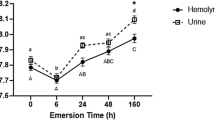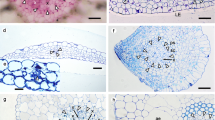Summary
In terrestrial isopods there are two types of a water conducting system. The porcellio-type is a recycling system. Out of the maxillar-nephridium urine is secreted, which spreads through the ventral and dorsal structures of the water conducting system. It is then directed along the pleopods and is reabsorbed in the gut. Within this system only urine runs. The ligiatype is an open system. Here urine runs as well as water, which is absorbed by the sixth and seventh pereiopods.
In all the species investigated incl. Ligia and Hemilepistus a water conducting system has been found. Apparently this system is constitutive for all terrestrial isopods. Concerning function (hypothesis): the water conducting system is multifunctional, but above all serving excretion. Isopods, also terrestrial isopods, are ammoniotelic. While the urine is spreading through the conducting structures ammonia is vapourizing off the increased surface. A special permeability of the integument needs not be assumed. After the urine having passed the anus, it is reabsorbed in the gut. The disadvantage of the ammoniotelism, the great demand of water, is avoided, the advantage, the economizing of energy, is preserved.
Additionally the water conducting system allows an active thermoregulation to a certain extent. Furthermore it has functions in respiration, conducting of water and keeping the integument humid and clean.
Zusammenfassung
1. Das Wasserleitungssystem der Oniscoidea wird einer Strukturanalyse unterzogen. Die Teilstrukturen des Systems werden dargestellt. Es wird gezeigt, daß das System seinen Anfang an der Harnöffnung des Cephalothorax nimmt, wo es den aus den Maxillarnephridien stammenden Harn aufnimmt und durch ventrale und dorsale Leitungsstrukturen zum Pleoventralraum leitet. Aus diesem wird der Harn durch den Anus wieder aufgenommen und vom Rectum resorbiert.
2. In der Strukturanalyse wird gezeigt, daß innerhalb der Oniscoidea zwei Typen des Wasserleitungssystems unterschieden werden können: der Porcellio-Typ und der Ligia-Typ. Bei grundsätzlicher Gleichheit beider Typen bestehen folgende Unterschiede: der Ligia-Typ hat an den 6. und 7. Pereiopoden Leitungsstrukturen, mit denen Wasser aufgesaugt wird. Im Wasserleitungssystem des Ligia-Typs fließt Harn und Wasser, in dem des Porcellio-Typs nur Harn.
3. Da die entwicklungsgeschichtlichen Extreme Ligia und Hemilepistus ein Wasserleitungssystem haben, bei 45 weiteren Arten verschiedener Familien keine Assel ohne ein solches System gefunden werden konnte, muß geschlossen werden, daß dieses System konstitutiv für alle Landasseln ist. Alle untersuchten Arten lassen sich einem der beiden System-Typen zuordnen.
4. Die vorgefundenen Strukturen werden auf ihre Funktion hin interpretiert. Es wird die Hypothese vertreten, daß das Wasserleitungssystem ein geschlossenes (Porcellio-Typ), multifunktionales System, vor allem aber integraler Bestandteil des Exkretionssystems ist. Das bei der Ammoniotelie auch terrestrischer Isopoden anfallende NH3 wird im Harn aus dem Körper entfernt. Aus dem Harn entweicht das NH3 wegen der enormen Oberflächenvergrößerung der Harnflüssigkeit beim Durchfluß durch die Leitungsstrukturen des Wasserleitungssystems. Der Harn selber wird nach Durchfließen des Pleoventralraumes durch die Endopodite und durch den Anus in den Körper wieder aufgenommen.
Der Nachteil der Ammoniotelie, der hohe Wasserbedarf, wird so aufgehoben und der Vorteil, die Energieersparnis, gewahrt. Darüber hinaus gehört das System zu den Funktionskreisen Respiration und Thermoregulation und hat außerdem Funktionen bei der Wasserleitung sowie bei der Feuchthaltung und Reinigung des Integuments.
5. Das Wasserleitungssystem wird als im Tierreich einzigartiger Weg erwiesen, die physiologischen Probleme des Landganges zu bewältigen.
Similar content being viewed by others
Literatur
Bepler H (1909) Über die Atmung der Oniscoideen. Diss Greifswald, pp 55
Dresel EB, Moyle V (1950) Nitrogenous excretion in amphipods and isopods. J Exp Biol 27:210–225
Edney EB (1951) The body temperature of woodlice. J Exp Biol 28:271–280
Edney EB (1953) The temperature of woodlice in the sun. J Exp Biol 30:331–349
Edney EB (1960) Terrestrial adaptations. In: Waterman TH (eds) The physiology of Crustacea Vol 1. Academic Press, New York, pp 367–393
Edney EB (1968) Transitions from water to land in isopod crustaceans. Am Zool 8:309–326
Edney EB (1977) Water balance in land arthropods. Springer, Berlin Heidelberg New York, p 282
Edney EB, Spencer J (1955) Cutaneous respiration in woodlice. J Exp Biol 32:256–269
Gruner HE (1954) Über das Coxalglied der Isopoden (Crustacea). Zool Anz 152:312–317
Hartenstein R (1968) Nitrogen metabolism in the terrestrial isopod, Oniscus asellus. Am Zool 8:507–519
Heeley W (1941) Observation on the life-histories of some terrestrial isopods. Proc Zool Soc London B111:79–149
Holdich DM, Lincoln RJ (1974) An investigation of the surface of the cuticle and associated sensory structures of the terrestrial isopod, Porcellio scaber. J Zool London 172:469–482
Kümmel G (1981) Fine Structural Indications of an Osmoregulatory Function of the “Gills” in Terrestrial Isopods (Crustacea Oniscoidea). Cell Tissue Res 214:663–666
Lindqvist OV (1968) Water regulation in terrestrial isopods, with comments on their behavior in a stimulus gradient. Ann Zool Fenn 5:279–311
Lindqvist OV (1971) Evaporation in terrestrial isopods is determind by oral and anal discharge. Experientia 27:1496–1498
Lindqvist OV (1972) Components of water loss in terrestrial isopods. Physiol Zool 45:316–324
Lindqvist OV, Fitzgerald G (1976) Osmotic interrelationship between blood and gut fluid in the isopod Porcellio scaber Latr. (Crustacea). Comp Biochem Physiol A53:57–59
Remmert H (1967) Physiologisch-ökologische Experimente an Ligia oceanica (Isopoda). Z Morphol Oecol Tiere 59:33–41
Schneider P (1970) Lebensweise und soziales Verhalten der Wüstenassel Hemilepistus aphganicus Borutzky 1958. Z Tierpsychol Tierernaehr Futtermittelkd 29:121–133
Schneider P (1975) Beitrag zur Biologie der afghanischen Wüstenassel Hemilepistus aphganicus Borutzky 1958 (Isopoda, Oniscoidea). Aktivitätsverlauf. Zool Anz 195:155–170
Schneider P, Tschakaroff-Schuster J (1978) Beitrag zur Orientierung und Ernährungsbiologie einheimischer Asseln (Crustacea, Isopoda). Mitt Dtsch Ges Allg Angew Entomol 1:47–57
Spencer JO, Edney EB (1954) The absorption of water by woodlice. J Exp Biol 31:491–496
Verhoeff KW (1908) Über Isopoden. Arch Biontol (Berlin) 2:335–387, pl 29–31
Verhoeff KW (1917) Zur Kenntnis der Atmung und der Atmungsorgane der Isopoda-Oniscoidea. Biol Zentralbl 37:113–127
Verhoeff KW (1920) Über die Atmung der Landasseln, zugleich ein Beitrag zur Kenntnis der Entstehung der Landtiere. Z Wiss Zool 118:365–447, pl 7–8
Warburg MR (1965) Water relations and internal body temperature of isopods from mesic and xeric habitats. Physiol Zool 38:99–109
Warburg MR (1968) Behavioral adaptations of terrestrial isopods. Am Zool 8:545–559
Wieser W (1972a) O/N ratios of terrestrial isopods at two temperatures. Comp Biochem Physiol 43A:859–868
Wieser W (1972b) Oxygen consumption and ammonia excretion in Ligia beaudiana M.-E., Comp Biochem Physiol 43A:869–876
Wieser W (1972c) A glutaminase in the body wall of terrestrial isopods. Nature (London) 239:288–290
Wieser W, Schweizer G (1970) A re-examination of the excretion of nitrogen by terrestrial isopods. J Exp Biol 52:267–274
Wieser W, Schweizer G (1972) Der Gehalt an Ammoniak und freien Aminosäuren, sowie die Eigenschaften einer Glutaminase bei Porcellio scaber (Isopoda). J Comp Physiol 81:73–88
Wieser W, Schweizer G, Hartenstein R (1969) Patterns in the release of gaseous ammonia by terrestrial isopods. Oecologia 3:390–400
Author information
Authors and Affiliations
Rights and permissions
About this article
Cite this article
Hoese, B. Morphologie und Funktion des Wasserleitungssystems der terrestrischen Isopoden (Crustacea, Isopoda, Oniscoidea). Zoomorphology 98, 135–167 (1981). https://doi.org/10.1007/BF00310433
Received:
Issue Date:
DOI: https://doi.org/10.1007/BF00310433




